Export To Excel in UWP TreeGrid (SfTreeGrid)
28 Feb 202524 minutes to read
SfTreeGrid provides support to export the data to Excel file. This also provides support to export the headers and stacked headers. This maintains the sorting and filtering process when exporting.
The following assemblies should be added for exporting a tree grid to Excel:-
- Syncfusion.SfGridConverter.UWP
- Syncfusion.XlsIO.UWP
For NuGet package, install Syncfusion.DataGridExcelExport.UWP package. For more details refer this UG link.
You can export the tree grid to Excel by using the ExportToExcel extension method present in Syncfusion.UI.Xaml.TreeGrid.Converter namespace.
using Syncfusion.UI.Xaml.TreeGrid.Converter;
var options = new TreeGridExcelExportingOptions();
options.ExcelVersion = ExcelVersion.Excel2013;
var excelEngine = treeGrid.ExportToExcel(options);
var workBook = excelEngine.Excel.Workbooks[0];
StorageFile storageFile = await KnownFolders.SavedPictures.CreateFileAsync("Sample" + ".xlsx", CreationCollisionOption.ReplaceExisting);
if (storageFile != null)
await workBook.SaveAsAsync(storageFile);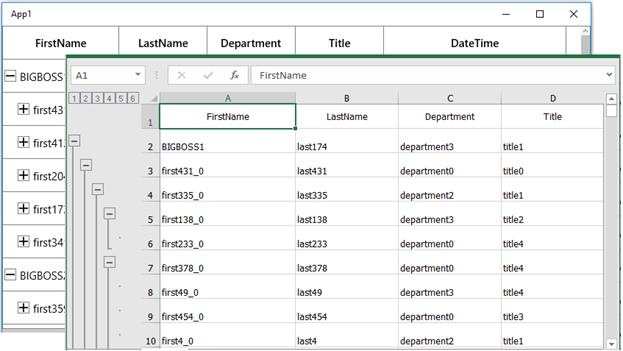
NOTE
SfTreeGrid exports data to Excel using XlsIO.
Export options
The exporting operation can be customized by passing TreeGridExcelExportingOptions instance as an argument to the ExportToExcel method.
Change export mode
By default, the actual value will only be exported to Excel. To export the display text, set the TreeGridExportMode property as Text.
var options = new TreeGridExcelExportingOptions();
options.ExcelVersion = ExcelVersion.Excel2013;
options.TreeGridExportMode = TreeGridExportMode.Text;
var excelEngine = treeGrid.ExportToExcel(options);
var workBook = excelEngine.Excel.Workbooks[0];
StorageFile storageFile = await KnownFolders.SavedPictures.CreateFileAsync("Sample" + ".xlsx", CreationCollisionOption.ReplaceExisting);
if (storageFile != null)
await workBook.SaveAsAsync(storageFile);Export without outlines
By default, all the children in the tree grid will be exported in expanded state. You can disable the outlines in Excel by setting the AllowOutliningGroups property to false in TreeGridExcelExportingOptions.
var options = new TreeGridExcelExportingOptions();
options.ExcelVersion = ExcelVersion.Excel2013;
options.AllowOutliningGroups = false;
var excelEngine = treeGrid.ExportToExcel(options);
var workBook = excelEngine.Excel.Workbooks[0];
StorageFile storageFile = await KnownFolders.SavedPictures.CreateFileAsync("Sample" + ".xlsx", CreationCollisionOption.ReplaceExisting);
if (storageFile != null)
await workBook.SaveAsAsync(storageFile);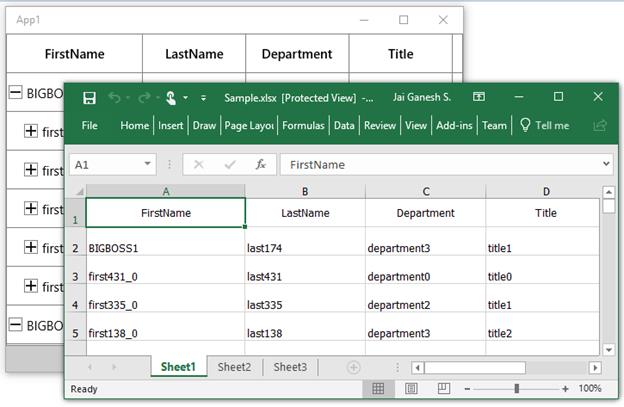
Exclude columns when exporting
By default, all the columns (including hidden columns) in the tree grid will be exported to Excel. To exclude some columns, use ExcludeColumns field in TreeGridExcelExportingOptions class.
var options = new TreeGridExcelExportingOptions();
options.ExcelVersion = ExcelVersion.Excel2013;
options.ExcludeColumns.Add("FirstName");
options.ExcludeColumns.Add("LastName");
var excelEngine = treeGrid.ExportToExcel(options);
var workBook = excelEngine.Excel.Workbooks[0];
StorageFile storageFile = await KnownFolders.SavedPictures.CreateFileAsync("Sample" + ".xlsx", CreationCollisionOption.ReplaceExisting);
if (storageFile != null)
await workBook.SaveAsAsync(storageFile);Here, the columns having FirstName and LastName as MappingName are excluded when exporting.
Excel version
When exporting to Excel, you can specify the Excel version by using the ExcelVersion property.
var options = new TreeGridExcelExportingOptions();
options.ExcelVersion = ExcelVersion.Excel2013;
var excelEngine = treeGrid.ExportToExcel(options);
var workBook = excelEngine.Excel.Workbooks[0];
StorageFile storageFile = await KnownFolders.SavedPictures.CreateFileAsync("Sample" + ".xlsx", CreationCollisionOption.ReplaceExisting);
if (storageFile != null)
await workBook.SaveAsAsync(storageFile);Export stacked headers to Excel
You can export the stacked headers to Excel by setting the ExportStackedHeaders property to true.
var options = new TreeGridExcelExportingOptions();
options.ExcelVersion = ExcelVersion.Excel2013;
options.ExportStackedHeaders = true;
var excelEngine = treeGrid.ExportToExcel(options);
var workBook = excelEngine.Excel.Workbooks[0];
StorageFile storageFile = await KnownFolders.SavedPictures.CreateFileAsync("Sample" + ".xlsx", CreationCollisionOption.ReplaceExisting);
if (storageFile != null)
await workBook.SaveAsAsync(storageFile);Export hyper-link to Excel
You can export the hyper-link to Excel by setting the CanExportHyperLink property to true.
var options = new TreeGridExcelExportingOptions();
options.ExcelVersion = ExcelVersion.Excel2013;
options.CanExportHyperLink = true;
var excelEngine = treeGrid.ExportToExcel(options);
var workBook = excelEngine.Excel.Workbooks[0];
StorageFile storageFile = await KnownFolders.SavedPictures.CreateFileAsync("Sample" + ".xlsx", CreationCollisionOption.ReplaceExisting);
if (storageFile != null)
await workBook.SaveAsAsync(storageFile);The default value of the CanExportHyperLink property is true.
Export column width to Excel
You can export the columns with its actual width by setting the ExportColumnWidth property to true.
var options = new TreeGridExcelExportingOptions();
options.ExcelVersion = ExcelVersion.Excel2013;
options.ExportColumnWidth = true;
var excelEngine = treeGrid.ExportToExcel(options);
var workBook = excelEngine.Excel.Workbooks[0];
StorageFile storageFile = await KnownFolders.SavedPictures.CreateFileAsync("Sample" + ".xlsx", CreationCollisionOption.ReplaceExisting);
if (storageFile != null)
await workBook.SaveAsAsync(storageFile);The default value of the ExportColumnWidth property is true.
Export with customized row height
You can export the tree grid to Excel with customized row height by using the DefaultRowHeight property.
var options = new TreeGridExcelExportingOptions();
options.ExcelVersion = ExcelVersion.Excel2013;
options.DefaultRowHeight = 60;
var excelEngine = treeGrid.ExportToExcel(options);
var workBook = excelEngine.Excel.Workbooks[0];
StorageFile storageFile = await KnownFolders.SavedPictures.CreateFileAsync("Sample" + ".xlsx", CreationCollisionOption.ReplaceExisting);
if (storageFile != null)
await workBook.SaveAsAsync(storageFile);Export without grid lines
You can export the tree grid to Excel without grid lines by setting the IsGridLinesVisible property to false.
var options = new TreeGridExcelExportingOptions();
options.ExcelVersion = ExcelVersion.Excel2013;
options.IsGridLinesVisible = true;
var excelEngine = treeGrid.ExportToExcel(options);
var workBook = excelEngine.Excel.Workbooks[0];
StorageFile storageFile = await KnownFolders.SavedPictures.CreateFileAsync("Sample" + ".xlsx", CreationCollisionOption.ReplaceExisting);
if (storageFile != null)
await workBook.SaveAsAsync(storageFile);The default value of the IsGridLinesVisible property is true.
Export with indent column
You can export the tree grid to Excel with indent column to denote the nodes level by setting the AllowIndentColumn property to true.
var options = new TreeGridExcelExportingOptions();
options.ExcelVersion = ExcelVersion.Excel2013;
options.AllowIndentColumn = true;
var excelEngine = treeGrid.ExportToExcel(options);
var workBook = excelEngine.Excel.Workbooks[0];
StorageFile storageFile = await KnownFolders.SavedPictures.CreateFileAsync("Sample" + ".xlsx", CreationCollisionOption.ReplaceExisting);
if (storageFile != null)
await workBook.SaveAsAsync(storageFile);The default value of the AllowIndentColumn property is false.
Change the node expand state in Excel
You can change the node expanding state in Excel by using the NodeExpandMode property.
var options = new TreeGridExcelExportingOptions();
options.ExcelVersion = ExcelVersion.Excel2013;
options.NodeExpandMode = NodeExpandMode.CollapseAll;
var excelEngine = treeGrid.ExportToExcel(options);
var workBook = excelEngine.Excel.Workbooks[0];
StorageFile storageFile = await KnownFolders.SavedPictures.CreateFileAsync("Sample" + ".xlsx", CreationCollisionOption.ReplaceExisting);
if (storageFile != null)
await workBook.SaveAsAsync(storageFile);Change start row and column index when exporting
You can export the data to specified row and column index in the worksheet, by setting the ExcelStartRowIndex and ExcelStartColumnIndex properties.
var options = new TreeGridExcelExportingOptions();
options.ExcelVersion = ExcelVersion.Excel2013;
options.ExcelStartColumnIndex = 3;
options.ExcelStartRowIndex = 3;
var excelEngine = treeGrid.ExportToExcel(options);
var workBook = excelEngine.Excel.Workbooks[0];
StorageFile storageFile = await KnownFolders.SavedPictures.CreateFileAsync("Sample" + ".xlsx", CreationCollisionOption.ReplaceExisting);
if (storageFile != null)
await workBook.SaveAsAsync(storageFile);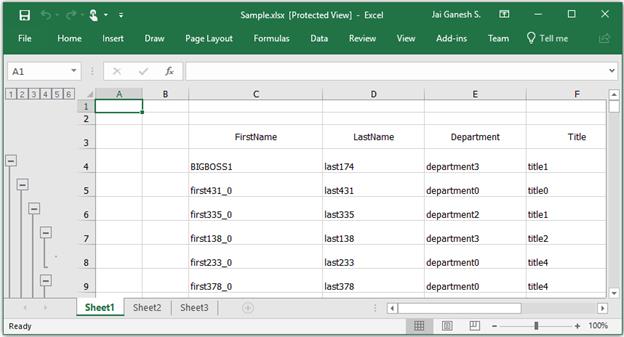
Save options
Save Excel as stream
After exporting to Excel, you can save the exported workbook as stream by using the SaveAsAsync method.
var options = new TreeGridExcelExportingOptions();
options.ExcelVersion = ExcelVersion.Excel2013;
var excelEngine = treeGrid.ExportToExcel(options);
IWorkbook workBook = excelEngine.Excel.Workbooks[0];
FileStream stream = null;
string directory = @"Pictures\output5.xlsx";
await Task.Run(() =>
{
stream = new FileStream(directory, FileMode.Create);
});
await workBook.SaveAsAsync(stream);
workBook.Close();
excelEngine.Dispose();Save Excel using FileSavePicker with MessageDialog
After exporting to Excel, you can save the exported workbook by opening the MessageDialog.
var options = new TreeGridExcelExportingOptions();
options.ExcelVersion = ExcelVersion.Excel2013;
var excelEngine = treeGrid.ExportToExcel(options);
IWorkbook workBook = excelEngine.Excel.Workbooks[0];
var savePicker = new FileSavePicker
{
SuggestedStartLocation = PickerLocationId.Desktop,
SuggestedFileName = "Sample"
};
if (workBook.Version == ExcelVersion.Excel97to2003)
savePicker.FileTypeChoices.Add("Excel File (.xls)", new List<string>() { ".xls" });
else
savePicker.FileTypeChoices.Add("Excel File (.xlsx)", new List<string>() { ".xlsx" });
var storageFile = await savePicker.PickSaveFileAsync();
if (storageFile != null)
await workBook.SaveAsAsync(storageFile);
var messageDialog = new MessageDialog("Do you want to view the Document?", "File has been created successfully.");
var yesCmd = new UICommand("Yes");
var noCmd = new UICommand("No");
messageDialog.Commands.Add(yesCmd);
messageDialog.Commands.Add(noCmd);
var cmd = await messageDialog.ShowAsync();
if (cmd == yesCmd)
{
// Launch the saved file
bool success = await Windows.System.Launcher.LaunchFileAsync(storageFile);
}
workBook.Close();
excelEngine.Dispose();Open the saved Excel file
You can open the saved workbook using FileOpenPicker.
var options = new TreeGridExcelExportingOptions();
options.ExcelVersion = ExcelVersion.Excel2013;
var excelEngine = treeGrid.ExportToExcel(options);
IWorkbook workBook = excelEngine.Excel.Workbooks[0];
StorageFile storageFile = await KnownFolders.SavedPictures.CreateFileAsync("Sample" + ".xlsx", CreationCollisionOption.ReplaceExisting);
if (storageFile != null)
await workBook.SaveAsAsync(storageFile);
FileOpenPicker openPicker = new FileOpenPicker();
openPicker.FileTypeFilter.Add(".xlsx");
openPicker.SuggestedStartLocation = PickerLocationId.PicturesLibrary;
StorageFile file = await openPicker.PickSingleFileAsync();
await Windows.System.Launcher.LaunchFileAsync(storageFile);Export to XML
You can save the exported workbook as Xml file by using the SaveAsXmlAsync method.
var options = new TreeGridExcelExportingOptions();
options.ExcelVersion = ExcelVersion.Excel2013;
var excelEngine = treeGrid.ExportToExcel(options);
IWorkbook workBook = excelEngine.Excel.Workbooks[0];
StorageFile storageFile = await KnownFolders.SavedPictures.CreateFileAsync("Sample", CreationCollisionOption.ReplaceExisting);
if (storageFile != null)
await workBook.SaveAsXmlAsync(storageFile, ExcelXmlSaveType.MSExcel);Export to CSV
You can save the exported workbook as CSV by using the SaveAsAsync method.
var options = new TreeGridExcelExportingOptions();
options.ExcelVersion = ExcelVersion.Excel2013;
var excelEngine = treeGrid.ExportToExcel(options);
var workBook = excelEngine.Excel.Workbooks[0];
var savePicker = new FileSavePicker
{
SuggestedStartLocation = PickerLocationId.Desktop,
SuggestedFileName = "Sample"
};
savePicker.FileTypeChoices.Add("Excel File (.csv)", new List<string>() { ".csv" });
var storageFile = await savePicker.PickSaveFileAsync();
await workBook.SaveAsAsync(storageFile, ",");
await Windows.System.Launcher.LaunchFileAsync(storageFile);
excelEngine.Dispose();Similarly, you can also save the exported worksheet to CSV. Refer to the XlsIO documentation.
Customize row height and column width
After exporting the data to Excel, you can set different row heights and column widths for the columns.
var options = new TreeGridExcelExportingOptions();
options.ExcelVersion = ExcelVersion.Excel2013;
var excelEngine = treeGrid.ExportToExcel(options);
IWorkbook workBook = excelEngine.Excel.Workbooks[0];
workBook.Worksheets[0].SetRowHeight(2, 50);
workBook.Worksheets[0].SetColumnWidth(2, 50);
StorageFile storageFile = await KnownFolders.SavedPictures.CreateFileAsync("Sample" + ".xlsx", CreationCollisionOption.ReplaceExisting);
if (storageFile != null)
await workBook.SaveAsAsync(storageFile);Customize cell appearance when exporting
You can customize the cells by using the CellsExportingEventHandler in ExcelExportingOptions.
Cell styling based on cell type in Excel
You can customize the cell styles based on the cell type by using the ExportingEventHandler property.
var options = new TreeGridExcelExportingOptions();
options.ExcelVersion = ExcelVersion.Excel2013;
options.ExportingEventHandler = ExportingHandler;
var excelEngine = treeGrid.ExportToExcel(options);
var workBook = excelEngine.Excel.Workbooks[0];
StorageFile storageFile = await KnownFolders.SavedPictures.CreateFileAsync("Sample" + ".xlsx", CreationCollisionOption.ReplaceExisting);
if (storageFile != null)
await workBook.SaveAsAsync(storageFile);
private static void ExportingHandler(object sender, TreeGridExcelExportingEventArgs e)
{
if (e.CellType == TreeGridCellType.HeaderCell)
{
e.Style.ColorIndex = ExcelKnownColors.Blue;
e.Handled = true;
}
else if (e.CellType == TreeGridCellType.RecordCell)
{
e.Style.ColorIndex = ExcelKnownColors.Sky_blue;
e.Handled = true;
}
}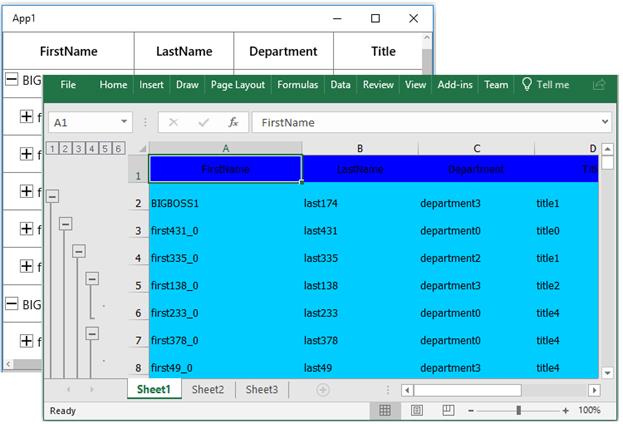
Customize the exporting content to Excel
You can customize the cell values when exporting to Excel by using the CellsExportingEventHandler property in TreeGridExcelExportingOptions.
var options = new TreeGridExcelExportingOptions();
options.ExcelVersion = ExcelVersion.Excel2013;
options.CellsExportingEventHandler = cellExportingHandler;
var excelEngine = treeGrid.ExportToExcel(options);
var workBook = excelEngine.Excel.Workbooks[0];
StorageFile storageFile = await KnownFolders.SavedPictures.CreateFileAsync("Sample" + ".xlsx", CreationCollisionOption.ReplaceExisting);
if (storageFile != null)
await workBook.SaveAsAsync(storageFile);
private static void CellExportingHandler(object sender, TreeGridCellExcelExportingEventArgs e)
{
// Based on the column mapping name and the cell type, we can change the cell
//values while exporting to excel.
if (e.CellType == TreeGridCellType.RecordCell && e.ColumnName == "IsClosed")
{
//if the cell value is True, "Y" will be displayed else "N" will be displayed.
if (e.CellValue.Equals(true))
e.Range.Cells[0].Value = "Y";
else
e.Range.Cells[0].Value = "N";
e.Handled = true;
}
}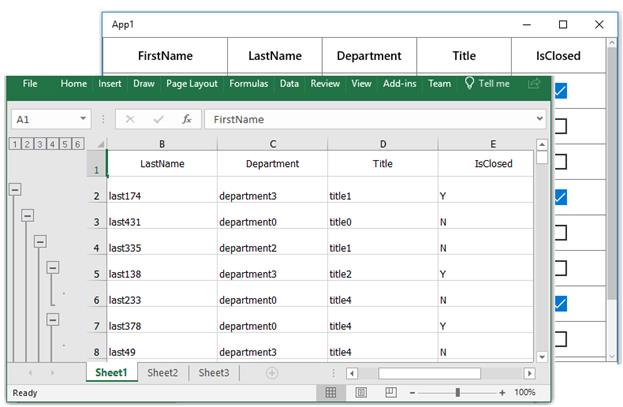
Here, the cell values changed for the IsClosed column are based on the custom condition.
Change row style in Excel based on data
You can customize the rows based on the record values by using the the CellsExportingEventHandler.
var options = new TreeGridExcelExportingOptions();
options.ExcelVersion = ExcelVersion.Excel2013;
options.AllowOutliningGroups = false;
options.CellsExportingEventHandler = CellExportingHandler;
var excelEngine = treeGrid.ExportToExcel(options);
var workBook = excelEngine.Excel.Workbooks[0];
workBook.SaveAs("Sample.xlsx");
private void cellExportingHandler(object sender, TreeGridCellExcelExportingEventArgs e)
{
if ((e.Node == null))
return;
var record = e.Node as EmployeeInfo;
if (record.Title == "title0")
{
e.Range.CellStyle.ColorIndex = ExcelKnownColors.Green;
e.Range.CellStyle.Font.Color = ExcelKnownColors.White;
}
}
Customize the cells based on column name
You can customize the cells based on the GridCellExcelExportingEventArgs.ColumnName property in CellsExportingEventHandler.
var options = new TreeGridExcelExportingOptions();
options.ExcelVersion = ExcelVersion.Excel2013;
options.AllowOutliningGroups = false;
options.CellsExportingEventHandler = CellExportingHandler;
var excelEngine = treeGrid.ExportToExcel(options);
var workBook = excelEngine.Excel.Workbooks[0];
workBook.SaveAs("Sample.xlsx");
private static void CellExportingHandler(object sender, TreeGridCellExcelExportingEventArgs e)
{
if (e.ColumnName != "ID")
return;
e.Range.CellStyle.Font.Size = 12;
e.Range.CellStyle.Font.Color = ExcelKnownColors.Pink;
e.Range.CellStyle.Font.FontName = "Segoe UI";
}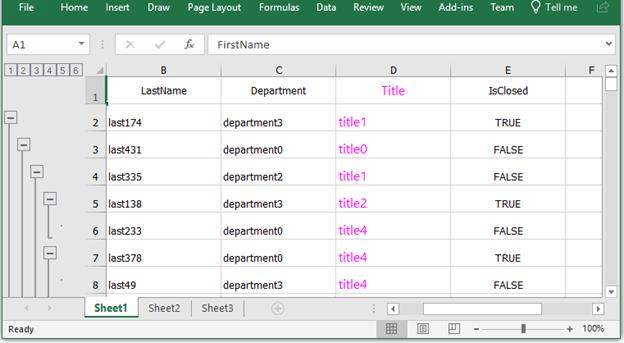
Customize exported workbooks and worksheets
The tree grid can be exported to Excel by using XlsIO. You can refer to XlsIO documentation for manipulating workbooks and sheets after exporting.
Set borders
You can set the borders to Excel cells by directly accessing worksheet after exporting the data.
var options = new TreeGridExcelExportingOptions();
options.ExcelVersion = ExcelVersion.Excel2013;
var excelEngine = treeGrid.ExportToExcel(options);
var workBook = excelEngine.Excel.Workbooks[0];
workBook.Worksheets[0].UsedRange.BorderInside(ExcelLineStyle.Dash_dot, ExcelKnownColors.Black);
workBook.Worksheets[0].UsedRange.BorderAround(ExcelLineStyle.Dash_dot, ExcelKnownColors.Black);
StorageFile storageFile = await KnownFolders.SavedPictures.CreateFileAsync("Sample" + ".xlsx", CreationCollisionOption.ReplaceExisting);
if (storageFile != null)
await workBook.SaveAsAsync(storageFile);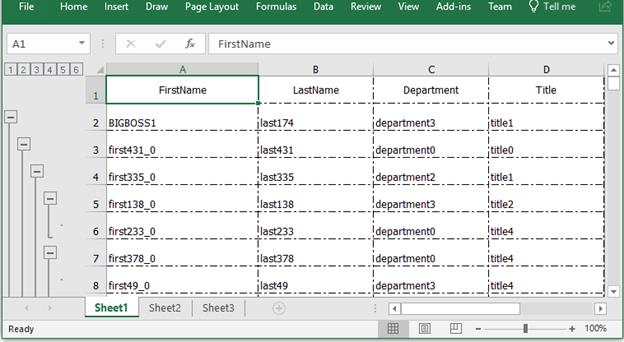
Enable filters
You can show filters in the exported worksheet by enabling filter for the exported range in the worksheet.
var options = new TreeGridExcelExportingOptions();
options.ExcelVersion = ExcelVersion.Excel2013;
var excelEngine = treeGrid.ExportToExcel(options);
var workBook = excelEngine.Excel.Workbooks[0];
workBook.Worksheets[0].AutoFilters.FilterRange = workBook.Worksheets[0].UsedRange;
StorageFile storageFile = await KnownFolders.SavedPictures.CreateFileAsync("Sample" + ".xlsx", CreationCollisionOption.ReplaceExisting);
if (storageFile != null)
await workBook.SaveAsAsync(storageFile);
By using the stacked headers, you can specify the range based on the stacked headers count.
var options = new TreeGridExcelExportingOptions();
options.ExcelVersion = ExcelVersion.Excel2013;
var excelEngine = treeGrid.ExportToExcel(options);
var workBook = excelEngine.Excel.Workbooks[0];
var range = "A" + (treeGrid.StackedHeaderRows.Count + 1).ToString() + ":" + workBook.Worksheets[0].UsedRange.End.AddressLocal;
excelEngine.Excel.Workbooks[0].Worksheets[0].AutoFilters.FilterRange = workBook.Worksheets[0].Range[range];
StorageFile storageFile = await KnownFolders.SavedPictures.CreateFileAsync("Sample" + ".xlsx", CreationCollisionOption.ReplaceExisting);
if (storageFile != null)
await workBook.SaveAsAsync(storageFile);You can refer to XlsIO documentation.
Customize the range of cells
You can customize the range of cells after exporting to Excel by directly manipulating the worksheet.
var options = new TreeGridExcelExportingOptions();
options.ExcelVersion = ExcelVersion.Excel2013;
var excelEngine = treeGrid.ExportToExcel(options);
var workBook = excelEngine.Excel.Workbooks[0];
workBook.Worksheets[0].Range["A2:A6"].CellStyle.Color = Colors.LightGray;
workBook.Worksheets[0].Range["A2:A6"].CellStyle.Font.Color = ExcelKnownColors.White;
StorageFile storageFile = await KnownFolders.SavedPictures.CreateFileAsync("Sample" + ".xlsx", CreationCollisionOption.ReplaceExisting);
if (storageFile != null)
await workBook.SaveAsAsync(storageFile);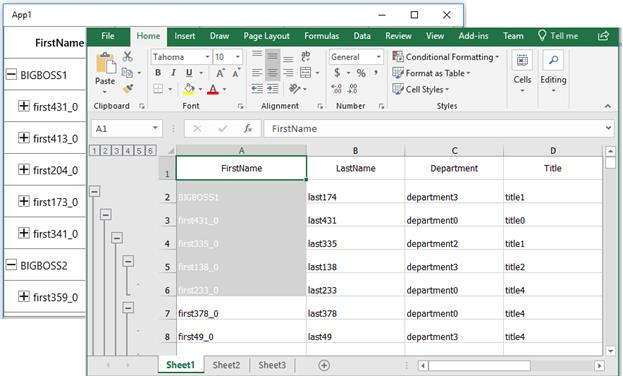
Performance
Using theExcelExportingOptions.CellsExportingEventHandler and changing the settings for each cell will consume more memory and time. So, avoid using the CellsExportingEventHandler and instead of this, you can do the required settings in the exported sheet.
Format column without using CellsExportingEventHandler
You can perform cell level customizations such as row-level styling, formatting a particular column in the exported worksheet.
In the following code snippet, NumberFormat for Employee ID column is changed in the exported sheet after exporting without using the CellsExportingEventHandler.
Reference:
http://help.syncfusion.com/file-formats/xlsio/working-with-cell-or-range-formatting
var options = new TreeGridExcelExportingOptions();
options.TreeGridExportMode = TreeGridExportMode.Value;
options.ExcelVersion = ExcelVersion.Excel2013;
var excelEngine = treeGrid.ExportToExcel(options);
IWorkbook workBook = excelEngine.Excel.Workbooks[0];
workBook.ActiveSheet.Columns[2].NumberFormat = "0.0";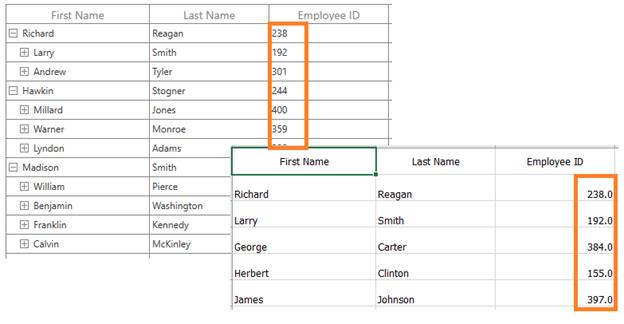
Alternate row styling without using CellsExportingEventHandler
In the following code snippet, the background color of the rows in Excel is changed based on the row index using conditional formatting for better performance.
Reference:
http://help.syncfusion.com/file-formats/xlsio/working-with-conditional-formatting
var options = new TreeGridExcelExportingOptions();
options.TreeGridExportMode = TreeGridExportMode.Value;
options.ExcelVersion = ExcelVersion.Excel2013;
var excelEngine = treeGrid.ExportToExcel(options);
IWorkbook workBook = excelEngine.Excel.Workbooks[0];
IConditionalFormats condition = workBook.ActiveSheet.Range[2, 1, this.treeGrid.View.Nodes.Count + 1, this.treeGrid.Columns.Count].ConditionalFormats;
IConditionalFormat condition1 = condition.AddCondition();
condition1.FormatType = ExcelCFType.Formula;
condition1.FirstFormula = "MOD(ROW(),2)=0";
condition1.BackColorRGB = System.Drawing.Color.Pink;
IConditionalFormat condition2 = condition.AddCondition();
condition2.FormatType = ExcelCFType.Formula;
condition2.FirstFormula = "MOD(ROW(),2)=1";
condition2.BackColorRGB = System.Drawing.Color.LightGray;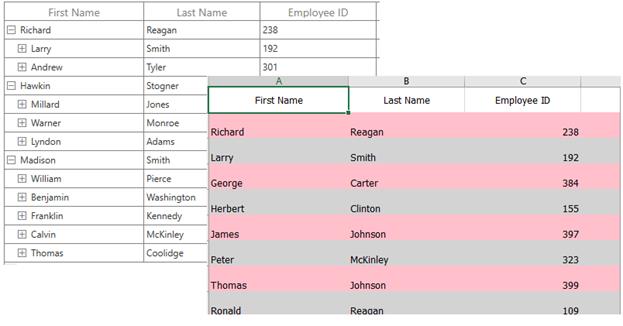
How to
Export multiple tree grids to a single Excel sheet
You can export multiple tree grids to a single Excel sheet by merging one tree grid worksheet into another using the Worksheet.UsedRange.CopyTo method.
var options = new TreeGridExcelExportingOptions();
options.ExcelVersion = ExcelVersion.Excel2010;
var excelEngine = treeGrid.ExportToExcel(options);
var workBook1 = excelEngine.Excel.Workbooks[0];
var worksheet1 = workBook1.Worksheets[0];
excelEngine = treeGrid1.ExportToExcel(options);
var workBook2 = excelEngine.Excel.Workbooks[0];
var worksheet2 = workBook2.Worksheets[0];
var columnCount = this.treeGrid1.Columns.Count;
//Merge the One TreeGrid WorkSheet into the other TreeGrid WorkSheet
worksheet2.UsedRange.CopyTo(worksheet1[1, columnCount + 1]);
StorageFile storageFile = await KnownFolders.SavedPictures.CreateFileAsync("Sample" + ".xlsx", CreationCollisionOption.ReplaceExisting);
if (storageFile != null)
await workBook1.SaveAsAsync(storageFile);Export the tree grid that is not loaded in view
You can export the tree grid that is not loaded in the view by calling the ApplyTemplate() method before exporting.
var options = new TreeGridExcelExportingOptions();
options.ExcelVersion = ExcelVersion.Excel2010;
treeGrid1.ApplyTemplate();
var excelEngine = treeGrid1.ExportToExcel(options);
var workBook1 = excelEngine.Excel.Workbooks[0];
var worksheet1 = workBook1.Worksheets[0];
StorageFile storageFile = await KnownFolders.SavedPictures.CreateFileAsync("Sample" + ".xlsx", CreationCollisionOption.ReplaceExisting);
if (storageFile != null)
await workBook1.SaveAsAsync(storageFile);Export parent and expanded child nodes
By default, all the tree grid nodes will be exported when exporting. You can export only the parent and expanded child nodes by overriding the ExportNodesToExcel method of TreeGridToExcelConverter class,
var options = new TreeGridExcelExportingOptions();
options.ExcelVersion = ExcelVersion.Excel2013;
var excelEngine = treeGrid.ExportToExcel(options, true);
var workBook = excelEngine.Excel.Workbooks[0];
StorageFile storageFile = await KnownFolders.SavedPictures.CreateFileAsync("Sample" + ".xlsx", CreationCollisionOption.ReplaceExisting);
if (storageFile != null)
await workBook.SaveAsAsync(storageFile);
public class TreeGridCustomExcelConverter : TreeGridToExcelConverter
{
internal bool _excludeNonExpandedNodes;
public TreeGridCustomExcelConverter(bool excludeNonExpandedNodes) : base()
{
_excludeNonExpandedNodes = excludeNonExpandedNodes;
}
protected override void ExportNodesToExcel(SfTreeGrid treeGrid, TreeNodes nodes, IWorksheet sheet, TreeGridExcelExportingOptions excelExportingOptions)
{
if (!_excludeNonExpandedNodes)
{
base.ExportNodesToExcel(treeGrid, nodes, sheet, excelExportingOptions);
}
else
{
for (int i = 0; i < nodes.Count; i++)
{
TreeNode node = nodes[i];
ExportNodeToExcel(treeGrid, node, sheet, excelExportingOptions);
if (node.IsExpanded && node.HasChildNodes)
{
node.PopulateChildNodes();
ExportNodesToExcel(treeGrid, node.ChildNodes, sheet, excelExportingOptions);
}
}
}
}
}You can download the sample here.